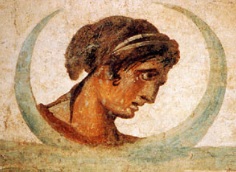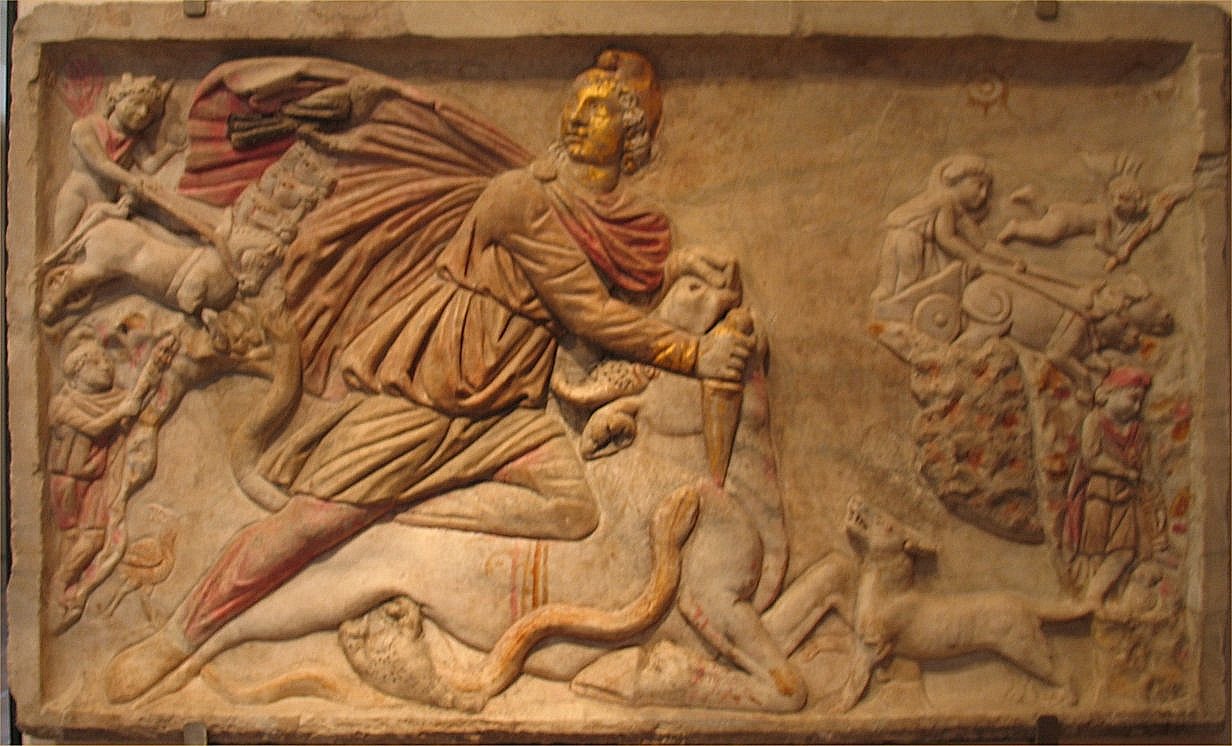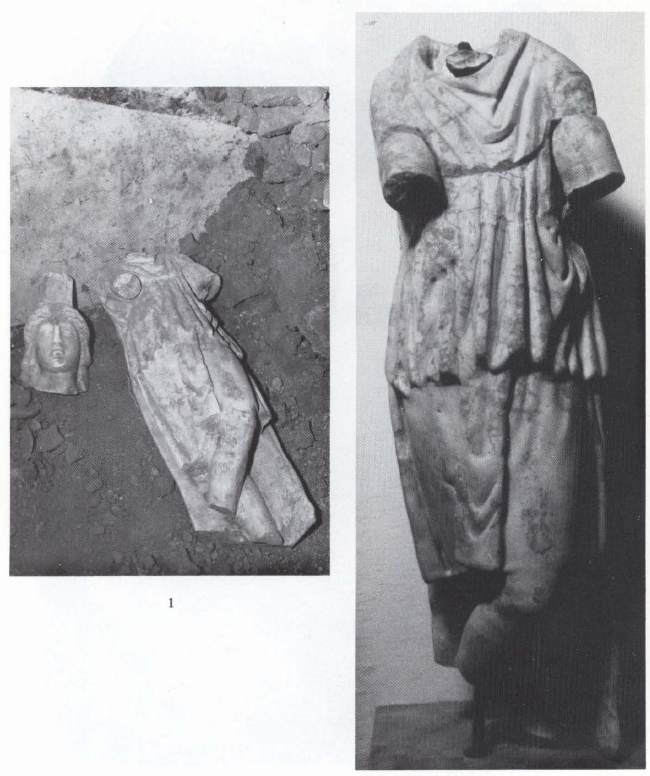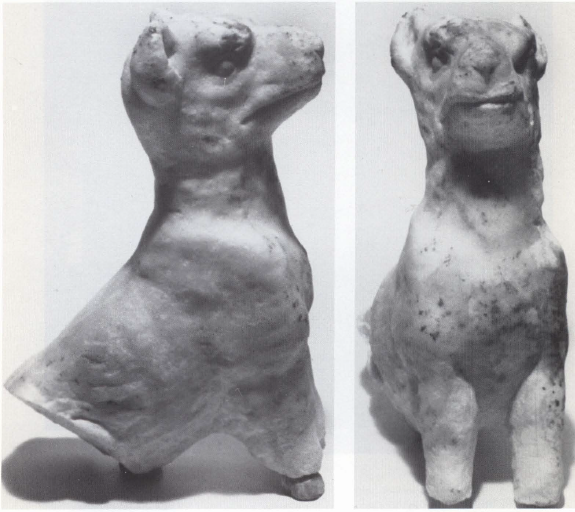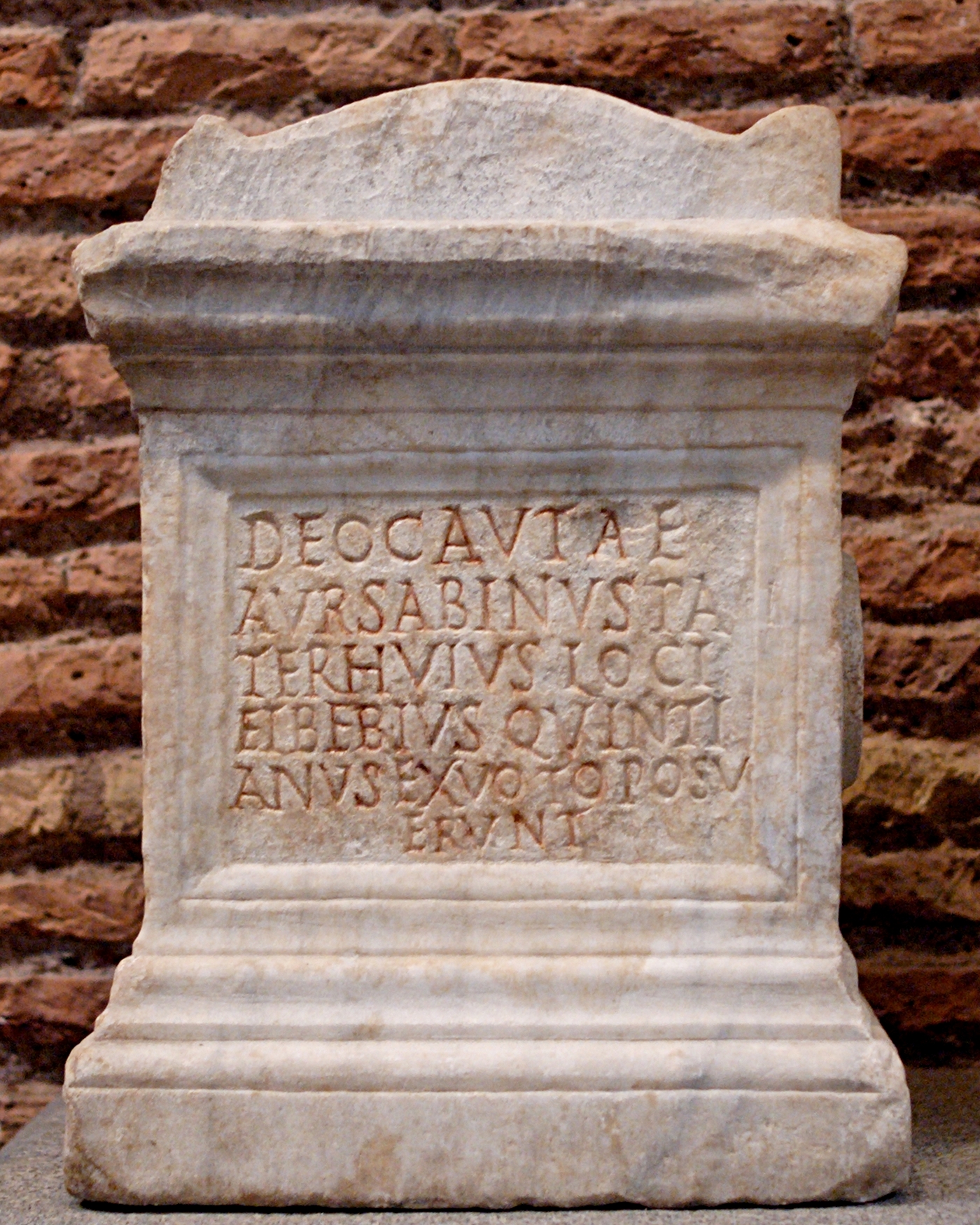
CIMRM Supplement - Mithraeum. S.Stephano Rotondo / Castra Peregrinorum, Rome.
- 1. Discovery of the mithraeum
- 2. First phase
- 3. Second phase
- 4. Objects
- 4.1. Statue of Rock birth
- 4.2. Another statue of Rock birth
- 4.3. Large polychrome tauroctony
- 4.4. Very small marble tauroctony relief
- 4.5. Five fragments of small polychrome tauroctony
- 4.6. Statuette of torchbearer
- 4.7. Statuette of dog
- 4.8. Head of Isis
- 4.9. Statuette of Telesphorus
- 4.10. Other finds
- 5. Inscriptions
- 6. Bibliography

In 1973-5 a mithraeum was discovered under the church of S. Stephano Rotondo in Rome, in one of the buildings of the Castra Peregrinorum. The monuments are now in the museum of the Baths of Diocletian.
The barrack blocks of the Castra are long and thin and run north-south. Each is divided into two long rooms. Ca. 180AD, the north end of the western room of one of them was turned into a Mithraeum. Some time later, probably in the late 3rd century AD, judging from the monuments, the Mithraeum was widened by absorbing the corresponding part of the eastern room as well. It is unclear when the Mithraeum went out of use. But the monuments were all thrown down, and some were smashed. Unfortunately the stratigraphy of the site was entirely destroyed by the construction of the church above it in the late 5th century. The roof was originally vaulted, as remains of plaster make clear, but this was removed and the chamber filled with material as a base for the erection of the church.
1. Discovery of the mithraeum
The following notes have been abbreviated from the detailed excavation report by E. Lissi-Carrona, to which the reader is referred for more detail and notes.
During the 1960's the church of S. Stephano Rotondo was restored. The flooring was stripped away, to reveal a solid platform of material, from the period of Pope Simplicius (468-483 A.D.), on which the church had been built. Excavations in November 1969 and 1971-75 revealed remains of the buildings of the Castra Peregrinorum. In one of these buildings (B), in 1973-5, a Mithraeum was discovered.
B (9.5 x 14 m) is a building constructed in opus testaceum, of red and yellow brick. It was built around 160 AD, and is recognisably designed to house troops. It consists of two long parallel rooms, themselves sub-divided into smaller chambers. The walls were frescoed (also ca. 160 AD), in white panels divided by red and green lines, and plant designs at the top of the panels. Some of this decoration was reused when part of the building was converted into a mithraeum.
2. First phase
Around 180 AD, part of the west room at the north end was converted into a Mithraeum. The room was 10 x 4.5m. The earlier floor was lowered, and then two benches constructed, and an altar, and a section of the north wall was converted to a niche, above the altar. The walls were over-painted and a polychrome relief in stucco and gilt was placed in the niche. The entrance door, on the south wall, was not aligned with the central naos. The western bench was 70cm high at the highest point, and 1.5m wide, and covered in thick red plaster. There are three 22cm wide travertine shelves embedded in the north wall. The central niche was 1.2m wide - its height is unknown since the top was cut away when the church was built. The niche frame was of brick, possibly covered with plaster.
On the west side of the niche was a painted bust of Sol, and a corresponding bust of Luna on the east side. Only a few rays survive of the Sol bust(pl.II) as the wall was cut away during the construction of the church. The bust of Luna is perfectly preserved (pl. III). It was painted directly onto the original barracks decoration, as narrow red lines from this appear below it. The head of the moon is in profile to the right, slightly reclining, inscribed in a crescent moon. The hair, fastened by a veil around the middle of the head, is collected in a krobylos. A corner of the veil falls on the neck, and there is a curl in front of the ear.
The niche contained a stucco high-relief tauroctony, as is proven by the presence, on the white plaster in the niche, guide-marks for fixing it in, and there are the remains of great iron nails (pl. XVIII, 2) in the niche, nails which are also embedded in the remains of the relief. Many fragments were found of the group; red from the coat of Mithras, brown from the bull, but not enough to reassemble it. The relief was 1.2m wide, filling the whole niche.

But from this relief the head of Mithras (inv. n. 205826) has survived (pl. I). It is 26cm high, and gilded. The phrygian cap is violet-red, and the face entirely covered with a thin sheet of gold. The intense use of colour, the structural soundness, and the nature of the decoration allow us to date this as within the 2nd c. A.D., and therefore belonging to the first phase of the mithraeum.
On the left hand side of the niche are traces of green stucco; on the right there seems to be a 46cm high figure with legs crossed, which is presumably one of the dadophores. Possibly the other was represented on the left.
3. Second phase
Towards the end of the 3rd c. AD, the mithraeum was enlarged. The wall on the east side, which originally divided the building B into two long barrack rooms, was demolished, creating a single large space, 10m x 9.5m. The eastern podium was destroyed in the process. A new and wider podium was built on the west side of opus vittatum mixtum. It was covered with red plaster, with the vertical face painted to resemble marble panels. The podium is 9.1m long. A rectangular niche appears in the middle of the vertical face, 50 x 50 cms and 44 cm deep. Two altar-shaped lamps were found in it (pl. XLI,2).
The eastern podium is similar, but the niche (4.9m from the north wall, 0.59m wide, 0.33m high, 0.295m deep) is semi-circular, and not directly opposite that on the west side. In this niche also an altar-shaped lamp (pl. XLI, 2).
A new altar was built, much larger than before, and of complex shape, with two steps leading up to it, similar to those in the mithraeum of the serpent at Ostia, producing a throne-like appearance. Like the podium, the altar is covered with red plaster, with the vertical panels painted to look like marble panels. The central steps are of travertine.
The original door on the south was closed and a new one in line with the east podium was opened up. Other alterations were made to the building to accomodate the new internal layout. The remains of a water tank have been found.
The frescoes were also altered. The east wall was demolished entirely during the construction of the church, so is unknown to us. But a rose-coloured hand appears on top of both Sol and Luna in the north wall, and some large red bands are painted on it. Further changes were made elsewhere. To the east of the entrance a large white crater was painted, made to look like marble, with two doves on the edge. The crater is common in mithraea (e.g. the mithraeum of Felicissimo, or the mosaic of the mithraeum of seven gates, both in Ostia), as a symbol of water. It is also common in gardens, and so in Mithraic art may refer to the fons perennis. A trapezoidal block of travertine with the clear imprint of tools and a cavity lined with the remains of lead (tav. 25, 1)is located 2.3m from the west podium and 1.56m from the east and 5m from the north wall. There was also a small enclosure between the altar and the east podium, of two pillars of marble with an interlocking vertical. Interestingly the pillar leaning against the altar has traces of blue and ends in a pine-cone.
To the south of the Mithraeum are three rooms. The south west room has a graffiti of the numeral XXVII, the middle room has red paint 1.4m high and white panels above that, with red painted shelves. On the east shelf was a marble statue of a dog. The south-east compartment has red bands painted directly onto the bricks.
4. Objects
Many of the objects found belong to the second phase of the mithraeum, and the cult images are of particular interest (fig. 9).
4.1. Statue of Rock birth

Between the western corner of the altar and the western podium, knocked on the floor and partly covered by the remains of the stucco relief, was the statue of Mithras born from the rock (inv.no 205827), 1.08m high, holding a knife in his right hand and a torch in his left, and wearing a phrygian cap. Mithras is rather older than usual in this statue. It is made of luna marble, and complete - the knife was found in two pieces and reassembled. The inscription below is rubricated.
Petram genetricem Aur(elius) Bassinus, aedituus principiorum cast(rorum) pereg(rinorum) dedicavit hoc in loco et d(ono) d(edit), antistante A. Caedicio Prisciano, eq(uite) R(omano), Patre.
The inscription is also given in Merkelbach.1
4.2. Another statue of Rock birth
Near the second step of the altar was found another statue of Mithras rock-born, also of luna marble (n.inv. 205828), 57cm high. Here Mithras is a child. The drill has been used extensively, indicating a date of the second half of the third century A.D. The torch and the knife are connected to the head by thick links. There is a little trace of red colour on the flame of the torch. The general standard of the work is poor.
4.3. Large polychrome tauroctony
At the altar and in the space between the altar and the west podium were found the pieces of a remarkable polychrome of the tauroctony (n.inv. 205837). 0.905m high, 1.48m wide, the frame often 6cm wide (pl. VIII-XIV). Between the head of Mithras and the head of the moon is the mark of a strong blow with a blunt instrument, presumably at the time of the destruction of the Mithraeum. Part of a leg of the quadriga of Sol, and part of Sol's face, is missing. The relief falls within the type 1 representation of Campbell.2
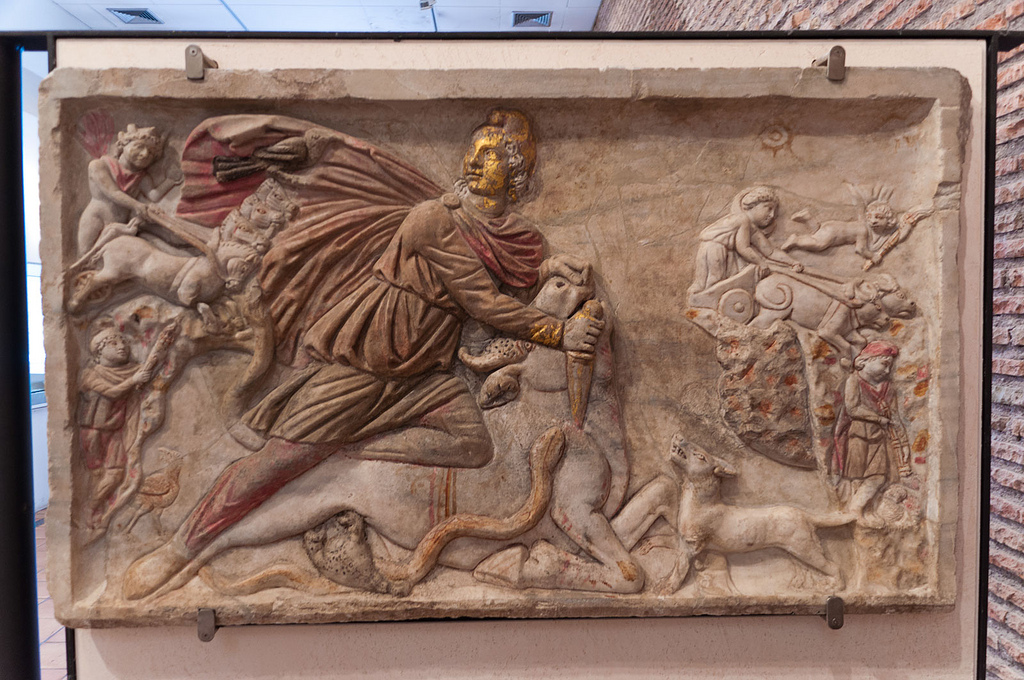
At the top left is the quadriga driven by Sol, wearing the corona radiata. He is wearing a short cloak that covers his chest and swells out behind him. He has the globe in his left hand, and holds the reins with his right.
At the top right is the chariot of the moon, drawn by two oxen. Luna, wearing a sleeved chiton, has the crescent moon behind her. She holds the reins with both hands. In front of her, above the chariot, hovers Hesperos, dressed in a cloak that covers the chest and swells behind, hands raised, and face towards Luna.
At the lower left is Cautes, in a tunica manicata (sleeved tunic), his cloak held on the right shoulder by a circular fibula. The cloak falls behind him. The rooster is at his feet.
At the lower right is Cautopates, similarly dressed, facing away from Mithras. At his feet is a bird, which should be interpreted as an owl.
Mithras plunges the knife into the bull, holding it by the left nostrils. Also wearing a sleeved tunic, anaxyrides and cloak fastened with a circular brooch on the right shoulder. Perched on Mithras' cloak, just in front of the heads of Sol's horses, is the raven. Below the bull, as usual, are the scorpion, snake and dog.
There are two unusual features to the relief; the presence of Hesperus hovering in front of the moon, and of the owl at the feet of Cautopates. Hesperus also appears in a relief in the Louvre, originally from Rome, depicted as a child with two torches in his hands, rushing headlong before the moon; and also in the Osterburken relief in the Badisches Landesmuseum at Karlsruhe. But the depiction of Hesperus flying before the moon is quite common on sarcophagi, such as that with the Capitoline divinites in the Ducal palace in Mantua.
The presence of the rooster at the feet of Cautes has been noticed elsewhere, but the presence of the owl at the feet of Cautopates is a first. However the Cautopates at Rusicade probably also has an owl at his feet, and an owl appears in the mosaic of the animals at Ostia. The owl represented darkness, as the rooster represented light.
The preservation of the colours, more than any other relief known, also makes this an important relief.
The abundant use of the drill in the treatment of hair and fur, and a widespread flattening of the figures allows us to date the relief to the end of the 3rd century A.D.
The relief was probably positioned behind the altar and in front of the cult niche.
4.4. Very small marble tauroctony relief
A very small marble relief of the tauroctony (n.inv.205838) was found at the altar. (pl. XV). 16.3 cm high, 16.5 cm wide, frame 4 cm. A small part of the lower right margin is missing. Abundant traces of colour on it. Also a Campbell type 1 relief.
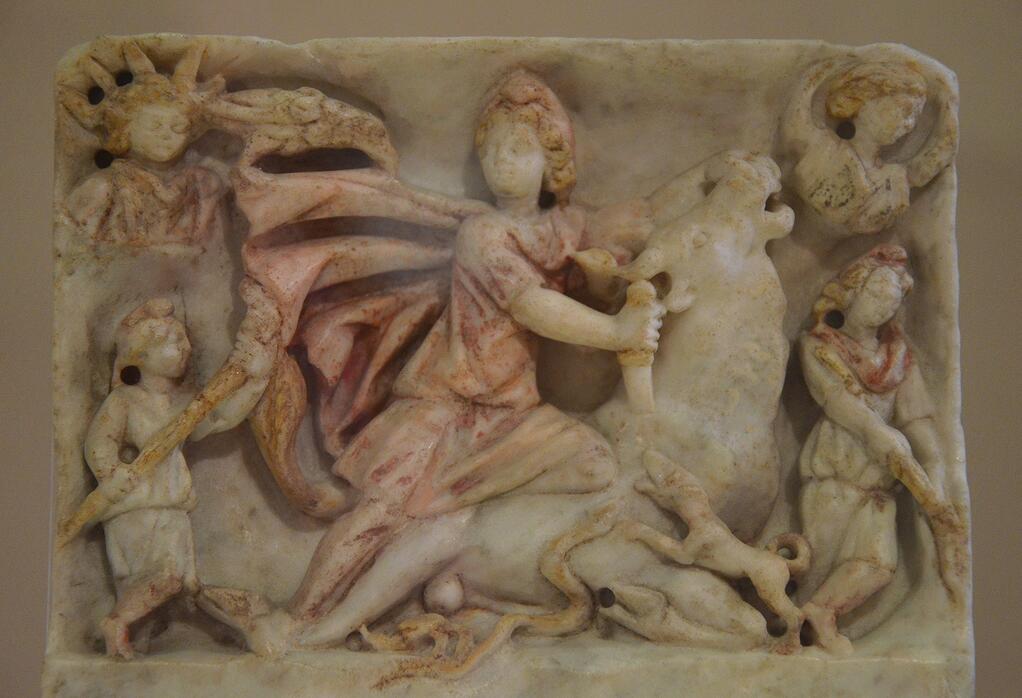
Miniature tauroctony. From: twitter by Following Hadrian. See also this Flickr image.
|

Same item in widely circulated photo. This example from here.
|

The whole item. From Flickr by Ryan Baumann.
|
At the top left is the head of Sol, wearing a crown with five rays. In the upper right corner is the head of the Moon, her face in profile to the right, the crescent behind her. Bottom left is Cautes, in sleeved tunic ,anaxyrides, left leg in front of the right. On the bottom right is Cautopates, with head and the torch turned to the right, i.e. towards the outside, also with sleeved tunic and anaxyrides. Mithras, wearing tunic with sleeves to the elbow, in the usual position, is slaying the bull, holding it with his left hand by the nostrils. The dog, the snake, and the scorpion are in the usual positions; the crow is resting on the billowing cloak of Mithras.
The relief work, despite the very small size, is very pronounced and the figures are almost in the round. The polychromy is abundantly preserved: Sol, with hair in yellow ochre. Moon: hair in yellow ocher. Cautes: torch and anaxyrides in yellow ochre. Cautopates: pileus, mantle and anaxyrides in red, torch in yellow ochre. Mithras: hair and anaxyrides in yellow ochre, red tunic and cloak. Raven black. Dog: the collar is shown with light vertical strokes in yellow ochre. Scorpio black.
The full body of the figures, the treatment of hair as still in a compact mass and the limited use of the drill, gives us a date between the late second and early third century. A.D. and therefore it can be attributed to the mithraeum's first phase.3
4.5. Five fragments of small polychrome tauroctony
Immediately to the south of the trapezoidal block in front of the altar were found five fragments of a small polychrome Mithraic relief of Danubian type (n.inv.205839). Of white marble, and 2cm thick, when intact it was about 35.5 x 23 cms. The relief, divided into three registers, is a Campbell type 4 relief.
More than half of the upper register is preserved; of the middle register only parts of the figures of Cautes and Cautopates; of the lower register only part of the lower left corner.
In the upper register, from the left, we see the birth of Mithras, distinguished by his phrygian cap. Then the bull inside a house; Mithras leading the bull with a rope (the bull does not want to walk so, as elsewhere, the god will be obliged to carry him over his shoulder); the bull in the ship; the water miracle.4
The dividing line between the top and middle registers follows the line of Mithras' phrygian cap.
Of the middle register, there remains on the left the upper portion of Cautes, with the phrygian cap, the mantle falling on his back, and the sleeved tunic (tunica manicata). Above his head is a bit of Mithras' cloak, and above that part of the body of the crow. In the fragment of the extreme left lower is preserved part of the foot of Cautes, part of the rear right leg of the bull and part of Mithras' foot.
In the two fragments on the right, Cautopates is almost entirely preserved, wearing a sleeved tunic (tunica manicata) and belt at the waist, the cloak, of which we see only a short flap on the right thigh, torch downwards and leg bent.
From the lower register we have just a single fragment, showing the dividing line, and a tiny bit of the relief, possibly part of a man's head.
There are abundant remains of colour. The lower register has traces of yellow, and the dividing lines between the registers are yellow. Likewise the hem of Mithras' cloak and the pileus and mantle of Cautes, the bull's hoof and the whole figure of Cautopates. The crow is in black. The background behind Cautopates in blue. On the left side are the remains of a vertical red band which was on the edge of the relief. Cautes' foot and the flame of the torch are in red.
The relief is very important because typologically it is similar to the otherwise unique relief found in 1935 at the Dolichenium on the Aventine. The latter was only in two registers, while this is in three; and fits into the types found along the Danube in Dacia. Presumably both reliefs were ex votos by a native of that region working in the Peregrini.
4.6. Statuette of torchbearer
On the west podium was found the fragments of a dadophore (n.inv.360177) (pl. XXXIV, 1). The statuette is missing head, forearms, and feet. Based on the position of the arms, it is probably Cautopates (pl. XXXIV,2). The tunic has no sleeves, with a mantle and anaxyrides. The mantle shows traces of red. The statuette has been restored in the past with iron pins too large for the limbs in question. 57cm in height.5
4.7. Statuette of dog
In the south-west room, on the west shelf, was a statuette of a dog, of luna marble. It is missing part of the front legs and all of the rear. It seems to have been designed to sit on its hind legs. 24cm high. Important in view of the frequent representation of the dog in the tauroctony reliefs and its presence in a mithraic context.6
4.8. Head of Isis
Two other items, not obviously Mithraic, were found in the Mithraeum. According to Ammianus Marcellinus the Castra Peregrinorum was still operating in 375 AD,7 and we know from epigraphic sources that it contained temples of Iovis Reducis, of the Genius Castrorum and Isis Regina. The construction of the church destroyed the stratigraphy of the Mithraeum site; so it is possible that these items were brought from elsewhere during the de-paganization of the site.8 This is supported by the presence near the entrance of some inscriptions which are purely military, or reference the Genius of the camp.9
On the east podium, close to the statue of Cautopates, was found a head of Isis of luna marble (n.inv. 205833)(Tav. XXXV), 22cm high. The feather above the disk is broken off and the head has suffered considerable other damage, consistent with being involved in destruction.10
4.9. Statuette of Telesphorus
A statuette of Telesphorus was found (n.inv.205835), 62.5cm high, of luna marble. (Pl. XXXVI-XXXVII)
Like the head of Isis, it is doubtful whether this has any connection with the mithraeum in which it was found.11
4.10. Other finds
In the area between the steps against the altar of the first phase and the western edge of the altar of the second phase, a marble altar was found, with a recess on the top entirely lined with lead. This must have contained a lamp.12
Another marble altar was found at the entrance to the east.(Pl. XXXVIII). Mouldings at top and bottom, with an urceus on the left face and a patera on the right.
Two marble supports in the shape of griffins (Pl. XXXIX) were found in the western part of the mithraeum, near the podium. (37 cm x 11 x 44 cm; 37 x 16 x 47 cm).
Two more supports, this time with the bodies of lions, were found to the east of the podium. (37 x 12 x 42 cm; 38 x 13 x 50 cm).
The supports are presumably for seats or benches. But these might support some form of table, like those trapezoidal items found in the mithraeum of Fructosus at Ostia and in a similar way in the Aldobrandi Mithraeum also at Ostia.
Two marble basins were found.(Pl. XL, 2), 9cm high, 43 x 30cm with a depth of 4cm. One next to the western, one next to the eastern podium. Basins have been found in a number of mithraea, for instance at Ostia in the Planta Pedis mithraeum.
A square marble labrum was found in its original location, next to the eastern podium and just forward of the niceh. (Pl. XLI,1) It contained ashes, bits of charcoal, and bones of fowl.
5. Inscriptions
Numerous inscriptions were found in the mithraeum, many of which obviously came in with the landfill as part of the construction of the church.13 Some are clearly original, however, being found on the floor of the mithraeum with no earth underneath them. They were classified by subject-matter into three groups by Silvio Panciera14. Lissi-Carrona discusses these briefly, mainly to indicate the location of each.
5.1. First group
See also the inscription on the rock-birth.
Marble altar to Cautes, found upside down near the entrance (n.inv.205832). 46 x 34 x 27 cm. Patera on right face, fulmen on the left face. Pinacles, and upper face pierced with five holes, perhaps for some metal object.15
On the front:
Deo Cautae Aur(elius) Sabinus, Pater huius loci, et Bebius Quintianus ex voto posuerunt.
On left face, the second line partially overlapping the fulmen:
Leo vivas cum Caedicio Patre.
From Wikimedia Commons.16
This states: "Reference: AE 1980, 00049. Photographed by Marie-Lan Nguyen, 2006."
The main inscription means, "To the god Cautes. Aurelius Sabinus, Pater of this place, and Baebius Quintianus, set this up in fulfilment of a vow." The left face inscription: "Lion, may you live, when Caedicius was Pater."17
Merkelbach states that the thunderbolt is the symbol of the "Lion" grade of initiation.18
Marble altar to Cautopates, found upside down near the west podium near the niche. (n.inv.205823), 47 cm high x 32.5 x 30 cm. In the centre of the pediment an eagle with wings extended. Patera on right face, fulmen on the left. Large rectangular recess on the top.
On the front:
Dea Cautaeopati Aur(elius) Sabinus, Pater huius loci, et Bebius Quintianus Leo, ex voto posuerunt.
On the right face, avoiding the relief of the patera:
Leo vivas cum Caedicio Patre
From: Flickr. By Hesperatusa. Aug. 14, 2010.
Translation: "To the god Caut{ae}opates. Aurelius Sabinus, Pater of this place, and Bebius Quintianus the Leo, set this up in fulfilment of a vow."
Merkelbach states that on the right side of the altar is a shell, symbol of the seventh grade of initiation.19
Coordinates: 41° 54' 00" N, 12° 30' 00" / 41.900° N, 12.500° E.20
5.2. Second group
Thirteen inscriptions which were found in or near the mithraeum but contain no explicit reference to the cult.
- Five marble altars dedicated by frumentarii and speculatores to the Genius (Sanctus) of the Castra Peregrinorum.
- Two altars dedicated "Signis legionum Severi et Antonini et Getae" by a centurion frumentarius.
- An ex voto altar, "Apollini Sancto" dedicated by a frumentarius.
- Marble altar by a princeps peregrinorum recording the restoration of a statue of Silvanus, "simulacrum Silvani, addito pronao, incendio consumptum".
- Two columns on which a centurio frumentarius fulfils a vow, with the usual words, "devotus numini maiestatique aeorum" (sic). Deity unspecified.
- Two dedications, at least one ex voto, by a centurio frumentarius to an unspecified god.
- Marble base of a bust of Geta, "devotus numini eius", by a centurio frumentarius.
5.3. Third group: altar with Cascelia's prayer
Engraved on all four sides of a marble altar (n.inv.359912)(20.2 cm high, at the base 13cm wide x 11.5 cm deep), found on the floor of the Mithraeum between the altar of phase 2 and the trapezoidal block, is a Latin text:
Domine aeterne, rogat te Cascelia Ele[g]ans, per misericordiam tuam [pro] se et pro suos o- mnes. Quomodo tu hibus c[ri]- atoribus mise- rtus es, rogat te aeter[ne], per te[r]- ram et marem divinum, per quidquid [b]oni creasti, per sal et seminata sac(ra) et mi et meis ro- gro[e]is miserearis. Per tuam pi- etatem, per legem vivam, per creatur(as) aeterne, te pro- pitium pro me[o] comser- vo et pro nata mea et pro domi- no meo Primo et Celia patro- ni, domine.
Translation by Ramsay McMullen and Eugene Lane, Paganism and Christianity, 100-425 C.E.: A Sourcebook, 1992 p.80.
"Eternal Lord, Cascelia Elegans asks you through your mercy, on her behalf and that of all who are hers, as you have shown mercy to these created beings[?], I ask you, Eternal One, by earth and sea divine, by whatever good thing you have created, by salt and sacred seed[?], be merciful to me and mine, I beg, by your piety, your living law, your creatures, Eternal One, [I beg?] you [to be] favouring, on behalf of my fellow slave and my daughter and my master Primus and Celia wife of my patron, Lord."
Lissi-Carrona notes that many questions are raised by this, since women were not admitted to the mysteries, and the mithraeum also stands within a military encampment. Whether the item was originally erected in the mithraeum is unclear.
See discussion here, Gerard Mussies, "Cascelia's prayer".
5.4. Scholarship
Merkelbach gives some information about the Mithraeum.21
Vermaseren says:22.
The recently discovered (April 1973) Mithraeum in the Castra peregrinorum will be published by Elisa Lissi-Caronna in EPRO (see Il Tempo 24.V.1973; Elissa Lissi-Caronna in Mysteria Mithrae, 205-212). The large cult relief preserves the paint; red for Mithras' dress; gold for his hands, neck and head.
Vermaseren adds that there is a painted representation of the tauroctony in the Mithraeum.23
Hinnells notes that the cult relief is gilded on both the god's face and the scorpion. Since the relief as a whole is not gilded, this indicates that the scorpion is not an evil creature.24
6. Bibliography
- Elissa Lissi-Carrona, Il Mitreo dei 'Castra Peregrinorum' (S. Stephano Rotondo), Leiden: Brill, 1986.
- Italian website.
| 1 | R. Merkelbach, Mithras: ein persisch-römischer Mysterienkult, 1994, p.178, n.88b. |
| 2 | L. A. Campbell, "Typology of Mithraic Tauroctones", Berytus XI, 1, 1954, p.10. |
| 3 | Lissi-Carrona, p.35-6. |
| 4 | Lissi-Carrona, p.36-7. |
| 5 | Lissi-Carrona, p.38. |
| 6 | Liss-Carrona, p.44-45 and pl. XLII. |
| 7 | XVI.12.66. |
| 8 | Lissi-Carrona, p.38. |
| 9 | p.39 |
| 10 | Lissi-Carrona, p.39. |
| 11 | Lissi-Carrona, p.40. |
| 12 | Liss-Carrona, p.40-1, and plates XXIX and XL, 1. |
| 13 | Lissi-Carrona, p.42. |
| 14 | "Mysteria Mithrae" pp.87-126. |
| 15 | Lissi-Carrona, p.42. |
| 16 | The data given on that page seems to relate rather to the Cautopates altar. |
| 17 | Trans.RP. |
| 18 | The inscription is also described in R. Merkelbach, Mithras: ein persisch-römischer Mysterienkult, 1994, p.178, n.88b. |
| 19 | R. Merkelbach, Mithras: ein persisch-römischer Mysterienkult, 1994, p.178, n.88c. |
| 20 | Supplied by John W. Brandt - thank you. |
| 21 | R. Merkelback, Mithras: ein persisch-römischer Mysterienkult, 1994, p.177-8. |
| 22 | M. J. Vermaseren, Mithriaca: The Mithraeum at Marino, Brill, 1982, p.4 |
| 23 | Mithriaca: The Mithraeum at Marino, Brill, 1982, p.35. He adds that it has been published by Elisa Lissia Corona in Mysteria Mithrae p. 206 and fig. 1. |
| 24 | John R. Hinnells, "Reflections on the Bull Slaying scene", in Mithraic Studies: Proceedings of the First International Congress of Mithraic Studies Manchester University Press, 1975, p.312. |
| Tweet |

